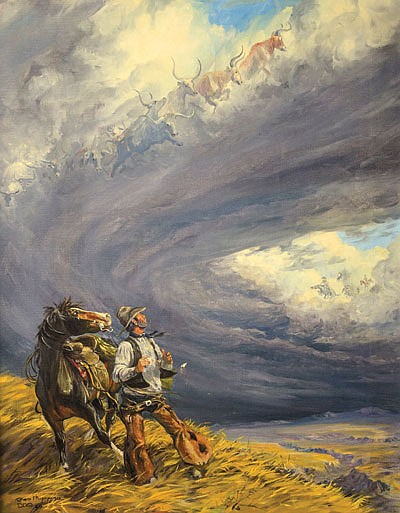
You could conceivably think of virtually every cute novelty hit, from pre-rock ditties like “How Much Is That Doggie In The Window” to transcendent rock-era staples like “Iko Iko,” as a legitimate precursor to bubblegum's avowedly ephemeral themes.
The Royal Guardsmen. They managed a #2 hit in 1966 with “Snoopy Vs. The Red Baron,” a novelty tune based on the funny-looking dog with the big black nose in the Peanuts comic strip. The single combined a campy kid's appeal with a punky bridge nicked without apology from “Louie, Louie.” Although “Snoopy Vs. The Red Baron” and its lower-charting sequels were certainly precursors to the recognized bubblegum sound, Bill Pitzonka insists The Royal Guardsmen were not a bona fide bubblegum group.
:format(jpeg):mode_rgb():quality(40)/discogs-images/A-227850-1546410144-9332.jpeg.jpg)

Playlists
Origins of "Riders in the Sky"

In this episode we take a look at the history of one of the most widely post WWII, "Covered" popular songs in the ASCAP publishing database.
From its humble beginnings as a European folk song to its re-appearance during the American Civil War asa melody for a drinking song, to its eventual use as she basis for a song about a cautionary tale warning a cowboy that if he doesn't change his ways, who will one day join the damned cowboys doomed to try to “catch the Devil”s herd across these endless skies.
Music Videos
While not an official video production from the estate of Marty Robbins, I really do think that this visual interpretation captures some the essence regarding "Riders in the Sky"
From a September 1990 episode of the CBS Television show "Hee Haw". Glen Campbell & Roy Clark play "Ghost Riders in the Sky", with some help from Jeff Dayton. Glen & Roy's version of this song is on the soundtrack album for the 1985 movie "Uphill All the Way", available at finer retailers everywhere!
This is 1961... (Restored footage). Levang was hired as a temporary guitar and banjo player on The Lawrence Welk Show when Buddy Merrill left to serve in the United States Army. Welk was so pleased with his ability that he hired Levang on a permanent basis when Buddy completed his tour of duty in 1961. Levang stayed with the Welk Band until its final show in 1982.
That same year, at the Country Music Association Awards he was nominated for best artist on a specialty instrument, the mandolin.
He was also an accomplished studio musician, playing on several records for artists such as Glen Campbell, Frank Zappa, Bobby Darin, Bobbi Gentry, David Clayton Thomas, Neal Hefti ("Batman Theme"), Elvis Presley, Dean Martin, Neil Diamond and Noel Boggs. Levang died in Canyon Country, California at the age of 83.
The ill fated reboot of the Blues Brothers movie franchise in the late 1990s tried to recapture the romance and legitimacy of the original film by relying on trade and true musical icons such as "Riders in the Sky".
Filmed in Toronto, Ontario Canada, most of which was shot in the Cherry Street area of Toronto in what is now the "Distillery District". The timing was right and so were the surroundings. The area had been a staging ground and ancillary storage and processing to the nearby Docklands south of Lakeshore Drive.
I watched the movie filming evolve on a daily basis during 1996/1997 as I drove Cherry St. Daily on my way to work. Sets going up and then controlled destruction of the concert hall included in this clip.
One of the first appearances of "Riders in the Sky" came during a 1949 episode of the movie by the same name. Singing Cowboy Gene Autry sings the Western Classic song "Ghost Riders in the Sky" from his movie "Riders in the Sky" from Columbia Pictures 1949.
By the mid 1980s, Duane Eddy had entered a new career awakening after his work with the Art of Noise and their reworking of the "Peter Gunn Theme". This time out we catch Duane flying his stylings all over our featured track. This video is from an American TV appearance in 1996.
In the USA, and more specifically, Texas is full of lore, legends, and ghost stories. The tale of the Ghost Riders is by far the saddest, most evil, not to mention, the most famous one in the country. This legend is sadly true, a senseless ghoulish tragedy which took place in Crosby County, Texas. You may know it as Stampede Mesa. The legend inspired the classic song “Ghost Riders in the Sky.”
Playlists
The TV Show . . .
The lead character was handsome, dashing, and consistently well-dressed in tailored suits, which never seemed to wrinkle even after the usual scuffles with the bad guys.
Edwards clearly modelled the character of Peter Gunn on Cary Grant, considered one of Hollywood’s most debonair leading men at the time. The actor chosen to play Gunn, Craig Stevens, even bore a close resemblance to Grant.
The series was set in Los Angeles (although the actual city was never mentioned by name in the series) and, more often than not, inside a jazz club called Mother’s.
The storyline essentially centred around Gunn solving his client’s problems (for which he charged $1000 a case), which always involved having to deal with an assortment of hitmen, hoodlums and assorted “hip” characters found on the jazz scene.
To get a feel for the show that inspired the music, here is Episode 1, Season 2 of the Peter Gunn television series.
During the 1980s the Peter Gunn show was revived for television in 1989. A long-gestating ABC 90-minute pilot, Peter Gunn aired in April 1989 with Peter Strauss in the lead role that was written, produced, and directed by Blake Edwards, but the network failed to order a series despite strong ratings and reviews. Take a look at the promo spot for the TV series, pay attention the very 1980s aesthetic.
The Art Of Noise
Although I've loved this song and video by the Art of Noise, it took about 30 years for me to recognize Rik Mayall as the star of this video. Rik and his friends such as great British comedians Adrian Edmondson, Jennifer Saunders, Dawn French, Alexei Sayle, Peter Richardson and Nigel Planer were seen on television screens in Britain and enjoyed immense success.
A rare appearance of both Duane Eddy and the Art of noise from their 1986 appearance on the British TV show "the Tube". BTW, Duane Eddy is still alive and kicking at age 82.
Blues Brothers
Originally performed for the seminal Blues Brothers movie, we catch the original members of the Blues Brothers band in a 1992 concert.
The Cramps
No collection of Peter Gunn videos would be complete without an entry featuring the Cramps lead guitarist Poison Ivy. She was the foremost female guitarist of the 1980s that left any mark on the alternative music world.
Cherry Wainer
Perhaps my all-time favourite version of the Peter Gunn theme is by the husband and wife duo of Cherry Wainer with Don Storer. This clip is from a German TV show during the mid 1960s. Cherry is so fun to watch. Clearly she loved to be on camera and to perform!
ELP (Emerson,Lake and Palmer)
While not taken from the 1977 Montreal concert where their live album was recorded, you still get a sense of their appreciation for the Classic Peter Gunn Theme. Emerson, Lake and Palmer opened their shows with the Peter Gunn theme as means of cheesing up the audience for what was to come during the rest of the concert.
Altec Lansing "Voice of the Theatre" Speakers
The speakers used to create the fabulous echo and reverse on the original Peter Gunn recordings were the classic -industry standard - Altec Lansing A-700 and A5 VOTT (Voice of the Theatre) Speakers. Read on for a look into the company, their speakers and the importance and impact they had on the music and film industries.
Altec Lansing, Inc. is a U.S. audio electronics company founded in 1927. Their primary products are loudspeakers and associated audio electronics for professional, home, automotive and multimedia applications.
Engineers at Western Electric, who later formed Altec Services Company, developed the technology for motion picture sound that was introduced in 1927, with the release of The Jazz Singer. Originally, Altec Services Company serviced the theatre sound systems the company founders had helped develop. In 1941 the Altec Services Company purchased the nearly bankrupt Lansing Manufacturing Company and melded the two names, forming the Altec Lansing Corporation, and with the manufacturing capabilities of the former Lansing Manufacturing Company, they quickly expanded into manufacturing horn loudspeakers.
For a really good look at the design and impact of the Voice of the Theatre Speaker History check out this link. Although the article can get a little technical, the author does a good job of presenting the reasons why the technology became a standard in the audio world.
The "Peter Gunn" Guitar
The Bob Bain story is an extremely long and varied one, detailed in this great article over at "Vintage Guitar" magazine. The Bob Bain Story.
Take the time to glance at the custom The Peter Gunn Guitar over at the Fender guitars page to see a photo of the original and some technical info about the limited edition reproduction guitar.












Social Media
Search Here